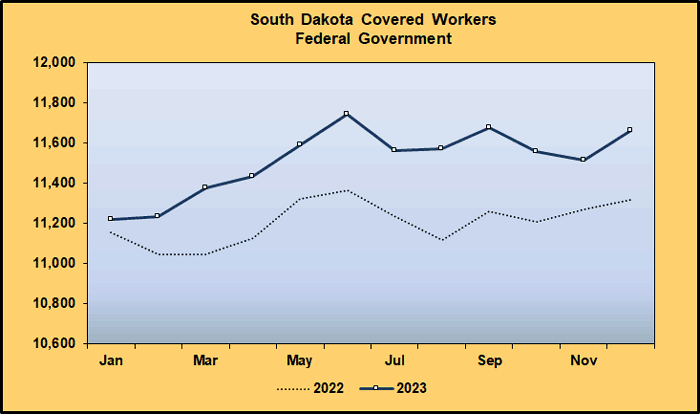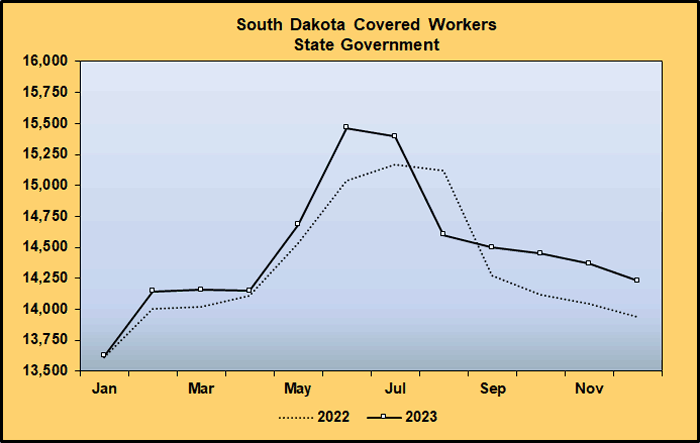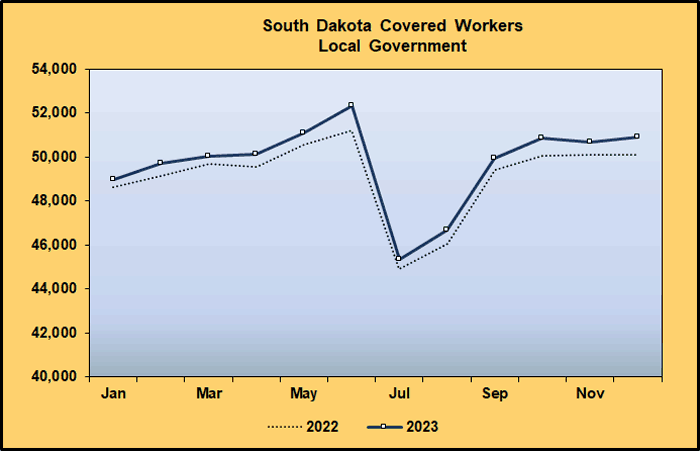- Home to LMIC
- Virtual Labor Market Data System
- Career Exploration & Planning
- Consumer Price Index
- Demographics
- Economic Snapshot
- Employee Benefits
- Employment Projections
- Labor Force & Unemployment
- Labor Supply
- Overview of the Current Labor Market
- Surveys We Conduct
- Wages & Income
- Workers by Industry
- Tools & Resources
- Publications
- References
- What's New
- Can't Find It?
Labor Market Information Center
2023 Annual Report
Quarterly Census of Employment and Wages
Public Administration Supersector
NAICS Sector 92
The Public Administration supersector contains information on Federal, State and Local Governments. Tribal governments are included in local government. A change in federal law requires Indian tribes to be classified similarly to state and local governments.
| South Dakota Covered Workers and Pay 2023 |
|||
| Supersector, Sector | Number of Establishments | Average Number of Workers | Annual Pay |
| Public Administration | 2,362 | 75,712 | $53,624 |
| Federal Government | 758 | 11,512 | $81,594 |
| Federal Government | 758 | 11,512 | $81,594 |
| State Government | 742 | 14,479 | $63,325 |
| State Government Education | 12 | 5,636 | $63,975 |
| State Government, excluding Education | 730 | 8,843 | $62,911 |
| Local Government | 862 | 49,721 | $44,322 |
| Local Government Education | 224 | 27,011 | $44,102 |
| Local Government, excluding Education and Tribal Government | 563 | 14,761 | $45,049 |
| Local Tribal Government, excluding Education | 43 | 6,128 | $41,946 |
| Local Tribal Government Education | 32 | 1,821 | $49,700 |
| See summed data for Local Tribal Government. Totals may not add due to rounding. Data subject to revision. Produced by the Labor Market Information Center, South Dakota Department of Labor and Regulation, in cooperation with the U.S. Bureau of Labor Statistics. |
|||
Federal Government
The number of Federal Government workers increased by 307 (2.7%) from 2022 to 2023 for a new total of 11,512. Federal government establishments during 2023 pointed to a $4,952 (6.5%) increase in annual pay for a new level of $81,594. This annual pay remains one of the highest paying industries in South Dakota.
Federal government is an arrangement of government that differentiates power between a strong larger central government and smaller local and state governments. The federal government is sometimes simply referred to as “Washington” and has three distinct branches: legislative, judicial, and executive, whose powers are vested by the U.S. Constitution in the congress, federal courts, and the president. Some areas of public life are under the control of the national government, and some areas are under control of the local governments. The constitution stipulates what areas of public life the federal government controls and what areas of public life the state governments regulate. Ideal examples of federal governments are those that function best in large countries where there exist broad diverse groups of people with unique needs with a common culture. Thus, the federal government helps to address the wide multiplicity of needs of a geographical area. Only the federal government can regulate interstate and foreign commerce, declare war, set taxing, spending and other national policies.
Federal worker levels in Administration of Human Resource Programs agencies experienced an increase of 86 workers during 2023. The new total of workers was 734. Annual pay had an increase of $6,080 to settle at $89,768. This category is represented by government establishments involved in administration of educational, public health, and veteran affairs programs. Public health programs and services require workers to carry out health activities, mental health assistance, and immunization services. Veteran’s affairs offices and benefits program administration often supply assistance, training, counseling, and other services to veterans and their dependents or survivors.
The Administration of Economic Programs workers increased 48 employees throughout 2023. These government establishments are primarily engaged in the administration, promotion, and development of economic resources, which includes business, industry, and tourism. Regulation of Agricultural Marketing and Commodities agencies are included in this industry, which had some recognizable gains in 2023. These establishments plan, administer, and coordinate agricultural programs for production and marketing. This industry grouping also had gains of federal workers associated with regulation, licensing, and inspection of commercial sectors such as retail trade, professional occupations, and construction services. Government establishments maintain physical standards and enforce regulatory practices.
Administration of Environmental Quality Programs realized a gain of 45 workers between 2022 and 2023. Almost all the worker gains were in government agencies primarily engaged in the administration, regulation, supervision, and control of land use. Included are recreational areas, and conservation and preservation of natural resources, weather forecasting administration, and the protection of public and private owned forest lands. This industry also incorporates agencies responsible for management and regulation of game, fish, and wildlife populations.
Several other public administrations subsectors experienced little if no gain in worker levels throughout 2023. This category contains National Security and International Affairs, Justice, Public Order, and Safety Activities, Executive, Legislative, and Other General Government Support establishments.

State Government
Worker numbers in State Government increased by 148 workers from 2022 to 2023 for a new total of 14,479 employees or 1.0%. The past few years have shown that state government employment has minor increases or decreases spread out amongst several agencies. In the same time frame, state government showed an increase in annual pay for a new level of $63,325, which equates to 8.5% growth.
State government is a component of government that uniquely makes and enforces laws for a state. State government is modeled after the Federal government and consists of three branches: executive, legislative, and judicial. The U.S. Constitution mandates all States uphold a form of government, although the three-branch structure is not required. State governments administer to the local needs of an area. State governments have certain reserved powers, specific authority, and responsibilities the national government does not have. In general, state governments are responsible for regulating trade within state borders and for establishing regulations for local corporations. State governments also administer to the needs of the many smaller local governments by establishing charters for county and city government. State governments play a dynamic role in regulating the educational system of their states and establishing licensing rules for professionals who practice in the state. State government exercises essential functions in the United States. They are responsible for governing to the local needs and problems of the state. The state constitution usually stipulates what powers and responsibilities state government has. States propose, strategize, and pay for most roads, operate public schools, provide water, establish zoning regulations, arrange elections for their citizens, and prepare policy.
Executive, Legislative and Other General Government Support agencies experienced some worker additions during 2023. This group increased by 68 workers, 9.2% growth. Annual pay also improved by 6.3% gaining $4,598 to close at $78,014 for the year. Public finance, taxation and monetary policy establishments are included in this cluster. Tax administration and collection, auditing activities, and property assessor offices are involved in maintaining their respective programs. The combination of executive and legislative offices are governmental establishments serving as councils and boards of commissioners.
State governmental agency components of Administration of Environmental Quality Programs had some minor gains in workers in 2023. Worker levels increased by 13 or 3.4%. The department of Environmental and Natural Resources was reorganized and became a component of the department of Agriculture back in 2022. This consolidation of departments eliminated some duplicative activities. Annual wages also increased by $4,465 to top off at $55,851 in 2023. Waste management, water control, and environmental protection programs are agencies classified here. On a bright note, like last year, some conservation programs ended up gaining more workers. Agencies in this industry helping account for the growth were land management administrations, recreation programs, and fish and wildlife programs. The public enjoys the many outdoor activities associated with these programs, and workers provide labor to carry out the many functions being offered.
Administration of Economic Programs experienced small worker increases throughout 2023. This grouping increased by 11 or 1.4%. Annual pay also increased, by 8.0% gaining $4,346 to finish at $58,978 for the year. The increase of workers was realized due to internal regrouping or redistribution of employees within departments of Environmental and Natural Resources, and Agriculture. Agriculture is the lifeblood of South Dakota and the state’s number one industry, so it is appropriate agencies continue to support agricultural-related programs. State government establishments administrate and coordinate marketing and promotional activities. Agencies in this industry also provide regulation and control of inspection of food, plants, animals, and other agricultural products.
Educational Services is an additional subsector that showed increases in employment during 2023. Tallying up the numbers resulted in a 64-worker spike. There were 5,636 employees working for the state in the educational field. Annual pay recorded a gain as well, reaching $63,975. Higher education institutions led the increase for this state worker category. There are many options for students to choose and with the flexible education programs now being offered, educators and staff are being added to the payrolls to meet demand.

Local Government
Local Government worker levels increased by 596 workers or 1.2% from 2022 to 2023 for a new figure of 49,721. Worker gains the past three years have made up for losses in 2020. Local government displayed a $1,913 or 4.5% increase in annual pay for a new level of $44,322 in 2023.
Local Government is an administrative body for a slighter-scale geographic area, such as a city, town, county, or district. Local governments are institutional units whose fiscal, legislative, and executive authority extends over the smallest geographical areas for administrative and political purposes. Local government refers to the operations of corporations, municipalities, district boards, and other bodies that are entrusted with the execution of functions relating to and concerning the residents of a given locality. Local governments extract their authority from the state in which they are located. Local governments routinely have control over their exclusive geographical region and cannot pass or enforce laws that will affect a wider area. Local governments can elect officials, enact taxes, and do many other things that a national government would do, but on a smaller scale. The authorities contracted to local governments originates from the state in which they are localized and from the state constitution.
Educational Services experienced an expansion in its worker levels throughout 2023. This industry gained 430 workers, finishing the year at an average of 27,011, growth of 1.6% over 2022. Annual pay increased to finish 2023 at $44,102, a 4.9% gain over the prior year. Elementary and secondary schools involved in delivering academic courses and associated course work that encompass a basic preparatory education multiplied its worker levels, comparable to last year’s gains. Establishments provide instruction and training in a wide selection of subjects. Junior colleges and community colleges are categorized under Educational Services and they displayed worker level expansion. These entities may provide instruction in diverse settings, such as the establishments or client’s training facilities, educational institutions, or the workplace. As was the situation in 2021, schools were close to being back to normal following the COVID-19 pandemic. Classrooms filled up again, and schools re-staffed accordingly to provide teaching and extra curriculum activities. Educational services' workforce makes up more than 50% of all the workers in local government. Local government plays a key role in public education in South Dakota and throughout the United States from kindergarten to community college. Local Government provides primary funding for public schools, using money largely raised through state and local taxes.
The public administration subsector Administration of Environmental Quality Programs produced a modest gain of five workers in 2023. Conservation programs such as fish and game agencies along with land management administrations and parks and recreational administrations accounted for these increases.
The remaining public administration subsectors yielded little or no change in employment levels. This includes Administration of Housing Programs, Urban Planning, and Community Development, Executive, Legislative, and Other General Government Support and Administration of Human Resource Programs. All these agencies and administrations provide an array of services and support. They are engaged with coordinating, planning, and supervising policies for their respective centralized programs.

